Optimization of the Loading of an Environmentally Friendly Compatibilizer Derived from Linseed Oil in Poly(Lactic Acid)/Diatomaceous Earth Composites
Abstract
1. Introduction
2. Experimental
2.1. Materials
2.2. Manufacturing of PLA/DE Composites Compatibilized with MLO
2.3. Characterization and Testing
2.3.1. Thermal and Thermo-Mechanical Characterization
2.3.2. Mechanical Characterization
2.3.3. Microscopic Characterization
3. Results and Discussion
3.1. Thermal Properties of PLA/DE Composites with Varying MLO Loading
3.2. Thermomechanical Properties of PLA/DE Composites with Varying MLO Loading
3.3. Mechanical Properties of PLA/DE Composites with Varying MLO Loading
3.4. Morphological Characterization of PLA/DE Composites with Varying MLO Loading
4. Conclusions
Author Contributions
Funding
Conflicts of Interest
References
- Quiles-Carrillo, L.; Blanes-Martinez, M.M.; Montanes, N.; Fenollar, O.; Torres-Giner, S.; Balart, R. Reactive toughening of injection-molded polylactide pieces using maleinized hemp seed oil. Eur. Polym. J. 2018, 98, 402–410. [Google Scholar] [CrossRef]
- Islam, M.R.; Beg, M.D.H.; Jamari, S.S. Development of Vegetable-Oil-Based Polymers. J. Appl. Polym. Sci. 2014, 131. [Google Scholar] [CrossRef]
- Lu, Y.; Larock, R.C. Novel Polymeric Materials from Vegetable Oils and Vinyl Monomers: Preparation, Properties, and Applications. ChemSusChem 2009, 2, 136–147. [Google Scholar] [CrossRef]
- Sharma, V.; Kundu, P.P. Addition polymers from natural oils—A review. Prog. Polym. Sci. 2006, 31, 983–1008. [Google Scholar] [CrossRef]
- Miao, S.; Wang, P.; Su, Z.; Zhang, S. Vegetable-oil-based polymers as future polymeric biomaterials. Acta Biomater. 2014, 10, 1692–1704. [Google Scholar] [CrossRef]
- Petrovic, Z.S.; Guo, A.; Javni, I.; Cvetkovic, I.; Hong, D.P. Polyurethane networks from polyols obtained by hydroformylation of soybean oil. Polym. Int. 2008, 57, 275–281. [Google Scholar] [CrossRef]
- Xia, Y.; Larock, R.C. Vegetable oil-based polymeric materials: Synthesis, properties, and applications. Green Chem. 2010, 12, 1893–1909. [Google Scholar] [CrossRef]
- Xia, Y.; Quirino, R.L.; Larock, R.C. Bio-based Thermosetting Polymers from Vegetable Oils. J. Renew. Mater. 2013, 1, 3–27. [Google Scholar] [CrossRef]
- Malarczyk, K.; Milchert, E. Methods for epoxidation of vegetable oils on heterogenous catalysts. Przem. Chem. 2015, 94, 412–415. [Google Scholar]
- Milchert, E.; Malarczyk, K.; Klos, M. Technological Aspects of Chemoenzymatic Epoxidation of Fatty Acids, Fatty Acid Esters and Vegetable Oils: A Review. Molecules 2015, 20, 21481–21493. [Google Scholar] [CrossRef] [PubMed]
- Tan, S.G.; Chow, W.S. Biobased Epoxidized Vegetable Oils and Its Greener Epoxy Blends: A Review. Polym. Plast. Technol. Eng. 2010, 49, 1581–1590. [Google Scholar] [CrossRef]
- Carbonell-Verdu, A.; Bernardi, L.; Garcia-Garcia, D.; Sanchez-Nacher, L.; Balart, R. Development of environmentally friendly composite matrices from epoxidized cottonseed oil. Eur. Polym. J. 2015, 63, 1–10. [Google Scholar] [CrossRef]
- Alam, J.; Alam, M.; Raja, M.; Abduljaleel, Z.; Dass, L.A. MWCNTs-Reinforced Epoxidized Linseed Oil Plasticized Polylactic Acid Nanocomposite and Its Electroactive Shape Memory Behaviour. Int. J. Mol. Sci. 2014, 15, 19924–19937. [Google Scholar] [CrossRef]
- Fenollar, O.; Garcia-Sanoguera, D.; Sanchez-Nacher, L.; Lopez, J.; Balart, R. Effect of the epoxidized linseed oil concentration as natural plasticizer in vinyl plastisols. J. Mater. Sci. 2010, 45, 4406–4413. [Google Scholar] [CrossRef]
- Ray, D.; Sain, S. Thermosetting bioresins as matrix for biocomposites. In Biocomposites for High-Performance Applications; Elsevier: Amsterdam, The Netherlands, 2017; pp. 57–80. [Google Scholar]
- Xing, C.; Matuana, L.M. Epoxidized soybean oil-plasticized poly(lactic acid) films performance as impacted by storage. J. Appl. Polym. Sci. 2016, 133. [Google Scholar] [CrossRef]
- Carbonell-Verdu, A.; Garcia-Sanoguera, D.; Jorda-Vilaplana, A.; Sanchez-Nacher, L.; Balart, R. A new biobased plasticizer for poly(vinyl chloride) based on epoxidized cottonseed oil (vol 33, 43642, 2016). J. Appl. Polym. Sci. 2016, 133. [Google Scholar] [CrossRef]
- Vijayarajan, S.; Selke, S.E.M.; Matuana, L.M. Continuous Blending Approach in the Manufacture of Epoxidized SoybeanPlasticized Poly(lactic acid) Sheets and Films. Macromol. Mater. Eng. 2014, 299, 622–630. [Google Scholar] [CrossRef]
- Sotoodeh-Nia, Z.; Hohmann, A.; Buss, A.; Williams, R.C.; Cochran, E.W. Rheological and physical characterization of pressure sensitive adhesives from bio-derived block copolymers. J. Appl. Polym. Sci. 2018, 135. [Google Scholar] [CrossRef]
- Carbonell-Verdu, A.; Dolores Samper, M.; Garcia-Garcia, D.; Sanchez-Nacher, L.; Balart, R. Plasticization effect of epoxidized cottonseed oil (ECSO) on poly(lactic acid). Ind. Crop. Prod. 2017, 104, 278–286. [Google Scholar] [CrossRef]
- Carbonell-Verdu, A.; Garcia-Garcia, D.; Dominici, F.; Torre, L.; Sanchez-Nacher, L.; Balart, R. PLA films with improved flexibility properties by using maleinized cottonseed oil. Eur. Polym. J. 2017, 91, 248–259. [Google Scholar] [CrossRef]
- Ernzen, J.R.; Bondan, F.; Luvison, C.; Wanke, C.H.; Martins, J.D.N.; Fiorio, R.; Bianchi, O. Structure and properties relationship of melt reacted polyamide 6/malenized soybean oil. J. Appl. Polym. Sci. 2016, 133. [Google Scholar] [CrossRef]
- Mauck, S.C.; Wang, S.; Ding, W.; Rohde, B.J.; Fortune, C.K.; Yang, G.; Ahn, S.-K.; Robertson, M.L. Biorenewable Tough Blends of Polylactide and Acrylated Epoxidized Soybean Oil Compatibilized by a Polylactide Star Polymer. Macromolecules 2016, 49, 1605–1615. [Google Scholar] [CrossRef]
- Rosu, D.; Mustata, F.; Tudorachi, N.; Musteata, V.E.; Rosu, L.; Varganici, C.D. Novel bio-based flexible epoxy resin from diglycidyl ether of bisphenol A cured with castor oil maleate. RSC Adv. 2015, 5, 45679–45687. [Google Scholar] [CrossRef]
- Ferri, J.M.; Garcia-Garcia, D.; Montanes, N.; Fenollar, O.; Balart, R. The effect of maleinized linseed oil as biobased plasticizer in poly (lactic acid)-based formulations. Polym. Int. 2017, 66, 882–891. [Google Scholar] [CrossRef]
- Agüero, A.; Quiles-Carrillo, L.; Jorda-Vilaplana, A.; Fenollar, O.; Montanes, N. Effect of different compatibilizers on environmentally friendly composites from poly (lactic acid) and diatomaceous earth. Polym. Int. 2019, 68, 893–903. [Google Scholar] [CrossRef]
- Brandelli, A.; Wentz Brum, L.F.; Zimnoch dos Santos, J.H. Nanostructured bioactive compounds for ecological food packaging. Environ. Chem. Lett. 2017, 15, 193–204. [Google Scholar] [CrossRef]
- Gorrasi, G.; Senatore, V.; Vigliotta, G.; Belviso, S.; Pucciariello, R. PET-halloysite nanotubes composites for packaging application: Preparation, characterization and analysis of physical properties. Eur. Polym. J. 2014, 61, 145–156. [Google Scholar] [CrossRef]
- Kumar, N.; Kaur, P.; Bhatia, S. Advances in bio-nanocomposite materials for food packaging: A review. Nutr. Food Sci. 2017, 47, 591–606. [Google Scholar] [CrossRef]
- Kuswandi, B. Environmental friendly food nano-packaging. Environ. Chem. Lett. 2017, 15, 205–221. [Google Scholar] [CrossRef]
- Rhim, J.-W.; Park, H.-M.; Ha, C.-S. Bio-nanocomposites for food packaging applications. Prog. Polym. Sci. 2013, 38, 1629–1652. [Google Scholar] [CrossRef]
- Tornuk, F.; Hancer, M.; Sagdic, O.; Yetim, H. LLDPE based food packaging incorporated with nanoclays grafted with bioactive compounds to extend shelf life of some meat products. LWT-Food Sci. Technol. 2015, 64, 540–546. [Google Scholar] [CrossRef]
- Aw, M.S.; Simovic, S.; Yu, Y.; Addai-Mensah, J.; Losic, D. Porous silica microshells from diatoms as biocarrier for drug delivery applications. Powder Technol. 2012, 223, 52–58. [Google Scholar] [CrossRef]
- Cacciotti, I.; Mori, S.; Cherubini, V.; Nanni, F. Eco-sustainable systems based on poly(lactic acid), diatomite and coffee grounds extract for food packaging. Int. J. Biol. Macromol. 2018, 112, 567–575. [Google Scholar] [CrossRef] [PubMed]
- Davoudizadeh, S.; Ghasemi, M.; Khezri, K.; Bahadorikhalili, S. Poly(styrene-co-butyl acrylate)/mesoporous diatomaceous earth mineral nanocomposites by in situ AGET ATRP. J. Therm. Anal. Calorim. 2018, 131, 2513–2521. [Google Scholar] [CrossRef]
- Medarevic, D.P.; Losic, D.; Ibric, S.R. Diatoms—nature materials with great potential for bioapplications. Hem. Ind. 2016, 70, 613–627. [Google Scholar] [CrossRef]
- Ozen, I.; Simsek, S.; Okyay, G. Manipulating surface wettability and oil absorbency of diatomite depending on processing and ambient conditions. Appl. Surf. Sci. 2015, 332, 22–31. [Google Scholar] [CrossRef]
- Saeidlou, S.; Huneault, M.A.; Li, H.; Park, C.B. Poly(lactic acid) crystallization. Prog. Polym. Sci. 2012, 37, 1657–1677. [Google Scholar] [CrossRef]
- Liu, M.; Zhang, Y.; Zhou, C. Nanocomposites of halloysite and polylactide. Appl. Clay Sci. 2013, 75, 52–59. [Google Scholar] [CrossRef]
- Tham, W.L.; Poh, B.T.; Ishak, Z.A.M.; Chow, W.S. Thermal behaviors and mechanical properties of halloysite nanotube-reinforced poly (lactic acid) nanocomposites. J. Therm. Anal. Calorim. 2014, 118, 1639–1647. [Google Scholar] [CrossRef]
- Prashantha, K.; Lecouvet, B.; Sclavons, M.; Lacrampe, M.F.; Krawczak, P. Poly (lactic acid)/halloysite nanotubes nanocomposites: Structure, thermal, and mechanical properties as a function of halloysite treatment. J. Appl. Polym. Sci. 2013, 128, 1895–1903. [Google Scholar] [CrossRef]
- De Silva, R.T.; Soheilmoghaddam, M.; Goh, K.L.; Wahit, M.U.; Bee, S.A.H.; Chai, S.P.; Pasbakhsh, P. Influence of the processing methods on the properties of poly (lactic acid)/halloysite nanocomposites. Polym. Compos. 2016, 37, 861–869. [Google Scholar] [CrossRef]
- Carbonell-Verdu, A.; Ferri, J.M.; Dominici, F.; Boronat, T.; Sanchez-Nacher, L.; Balart, R.; Torre, L. Manufacturing and compatibilization of PLA/PBAT binary blends by cottonseed oil-based derivatives. Express Polym. Lett. 2018, 12, 808–823. [Google Scholar] [CrossRef]
- Li, M.; Li, S.; Xia, J.; Ding, C.; Wang, M.; Xu, L.; Yang, X.; Huang, K. Tung oil based plasticizer and auxiliary stabilizer for poly(vinyl chloride). Mater. Des. 2017, 122, 366–375. [Google Scholar] [CrossRef]
- Prempeh, N.; Li, J.; Liu, D.; Das, K.; Maiti, S.; Zhang, Y. Plasticizing Effects of Epoxidized Sun Flower Oil on Biodegradable Polylactide Films: A Comparative Study. Polym. Sci. Ser. A 2014, 56, 856–863. [Google Scholar] [CrossRef]
- Carrasco, F.; Gamez-Perez, J.; Santana, O.O.; Maspoch, M.L. Processing of poly(lactic acid)/organomontmorillonite nanocomposites: Microstructure, thermal stability and kinetics of the thermal decomposition. Chem. Eng. J. 2011, 178, 451–460. [Google Scholar] [CrossRef]
- Quiles-Carrillo, L.; Montanes, N.; Sammon, C.; Balart, R.; Torres-Giner, S. Compatibilization of highly sustainable polylactide/almond shell flour composites by reactive extrusion with maleinized linseed oil. Ind. Crop. Prod. 2018, 111, 878–888. [Google Scholar] [CrossRef]
- Bocqué, M.; Voirin, C.; Lapinte, V.; Caillol, S.; Robin, J.J. Petro-based and bio-based plasticizers: Chemical structures to plasticizing properties. J. Polym. Sci. Part A Polym. Chem. 2016, 54, 11–33. [Google Scholar] [CrossRef]
- Silverajah, V.S.G.; Ibrahim, N.A.; Zainuddin, N.; Yunus, W.M.Z.W.; Abu Hassan, H. Mechanical, Thermal and Morphological Properties of Poly(lactic acid)/Epoxidized Palm Olein Blend. Molecules 2012, 17, 11729–11747. [Google Scholar] [CrossRef]
- Ali, F.; Chang, Y.-W.; Kang, S.C.; Yoon, J.Y. Thermal, mechanical and rheological properties of poly (lactic acid)/epoxidized soybean oil blends. Polym. Bull. 2009, 62, 91–98. [Google Scholar] [CrossRef]
- Shah, D.U. Developing plant fibre composites for structural applications by optimising composite parameters: A critical review. J. Mater. Sci. 2013, 48, 6083–6107. [Google Scholar] [CrossRef]
- Yu, Y.; Cheng, Y.; Ren, J.; Cao, E.; Fu, X.; Guo, W. Plasticizing effect of poly (ethylene glycol) s with different molecular weights in poly (lactic acid)/starch blends. J. Appl. Polym. Sci. 2015, 132. [Google Scholar] [CrossRef]
- Quiles-Carrillo, L.; Montanes, N.; Garcia-Garcia, D.; Carbonell-Verdu, A.; Balart, R.; Torres-Giner, S. Effect of different compatibilizers on injection-molded green composite pieces based on polylactide filled with almond shell flour. Compos. Part B Eng. 2018, 147, 76–85. [Google Scholar] [CrossRef]
- Silverajah, V.S.G.; Ibrahim, N.A.; Yunus, W.M.Z.W.; Abu Hassan, H.; Woei, C.B. A Comparative Study on the Mechanical, Thermal and Morphological Characterization of Poly(lactic acid)/Epoxidized Palm Oil Blend. Int. J. Mol. Sci. 2012, 13, 5878–5898. [Google Scholar] [CrossRef] [PubMed]

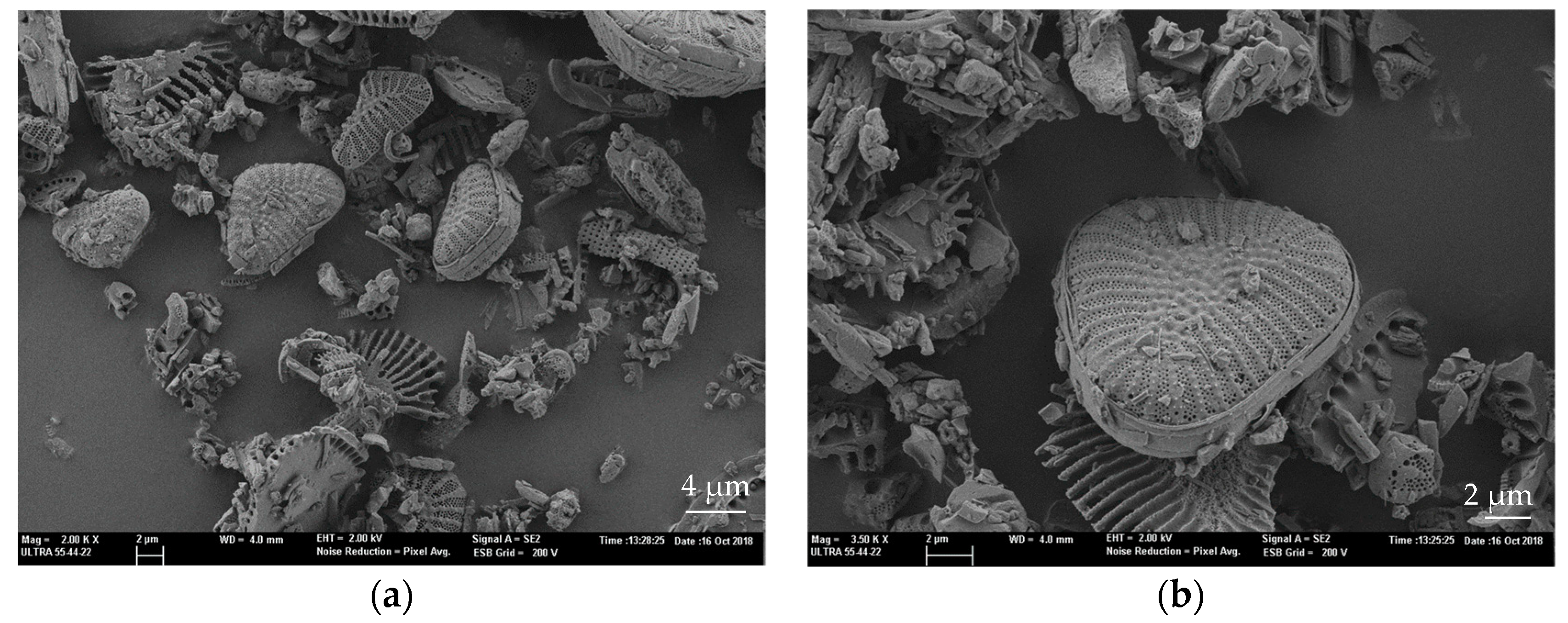
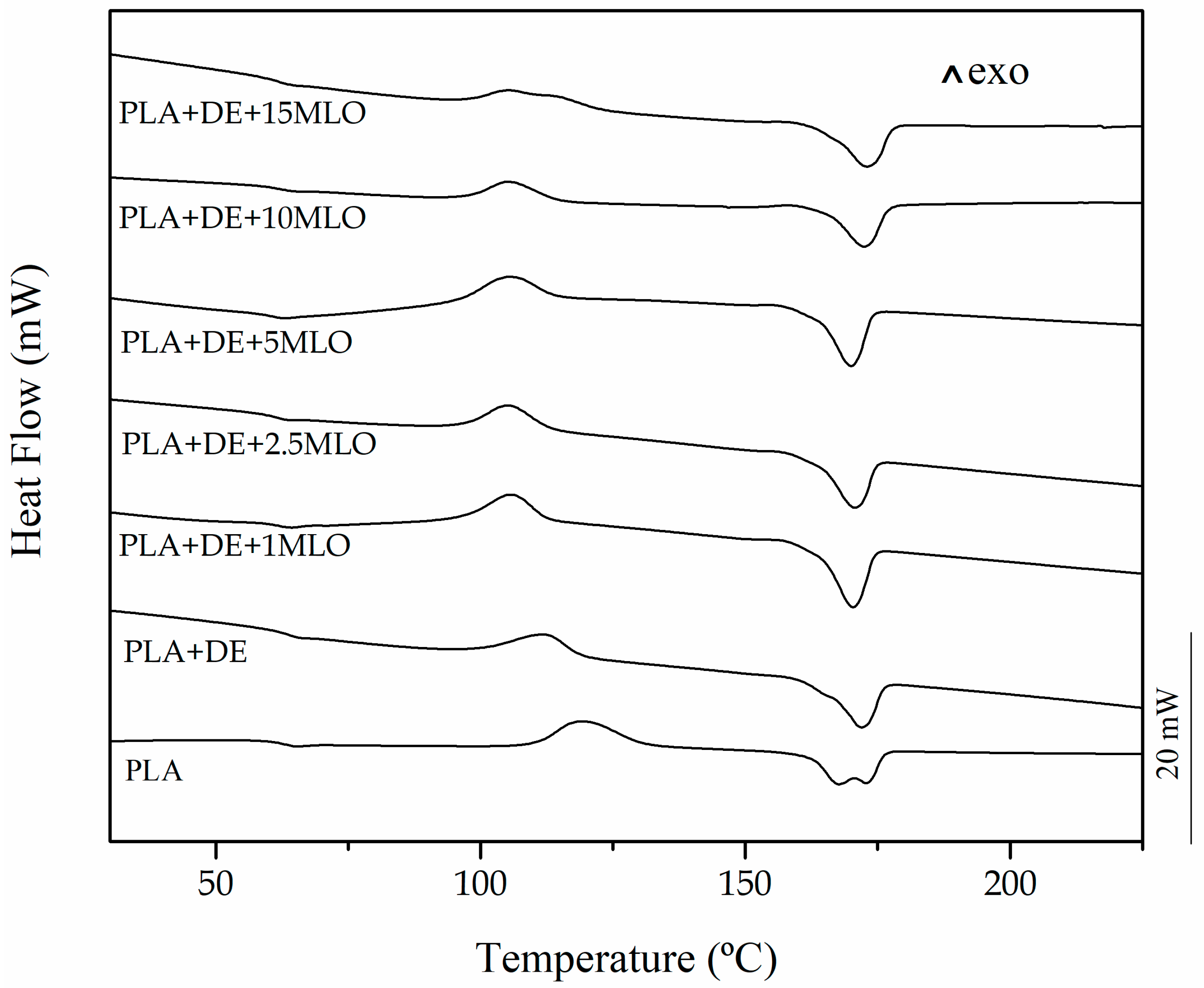
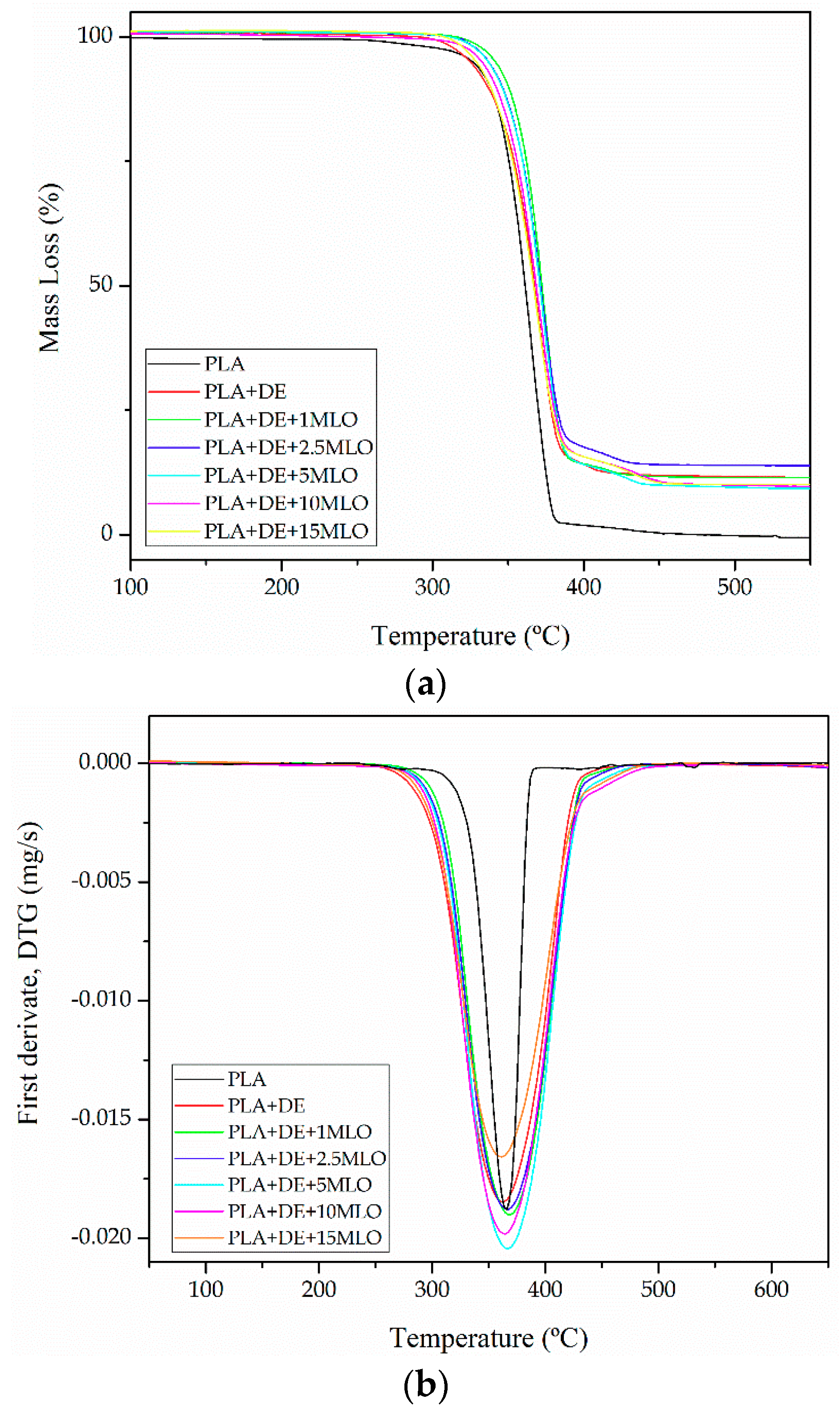
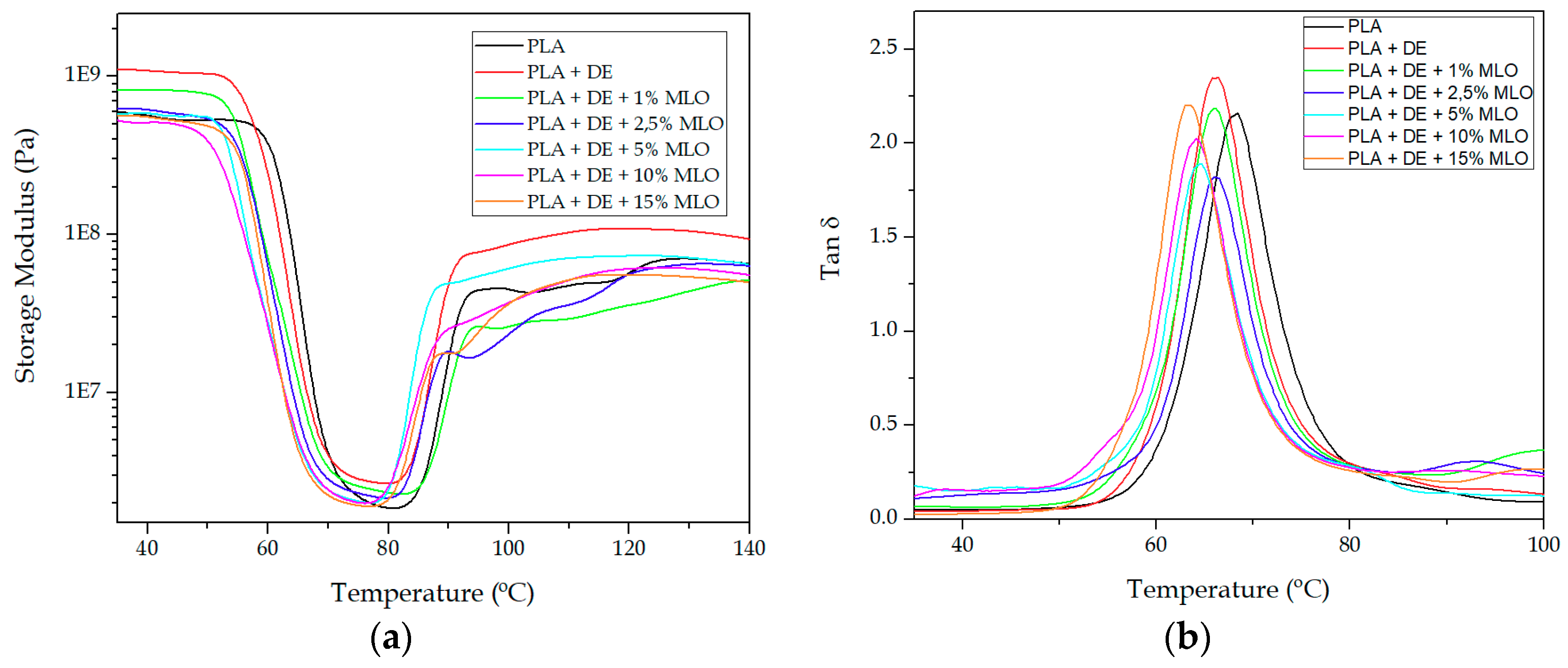
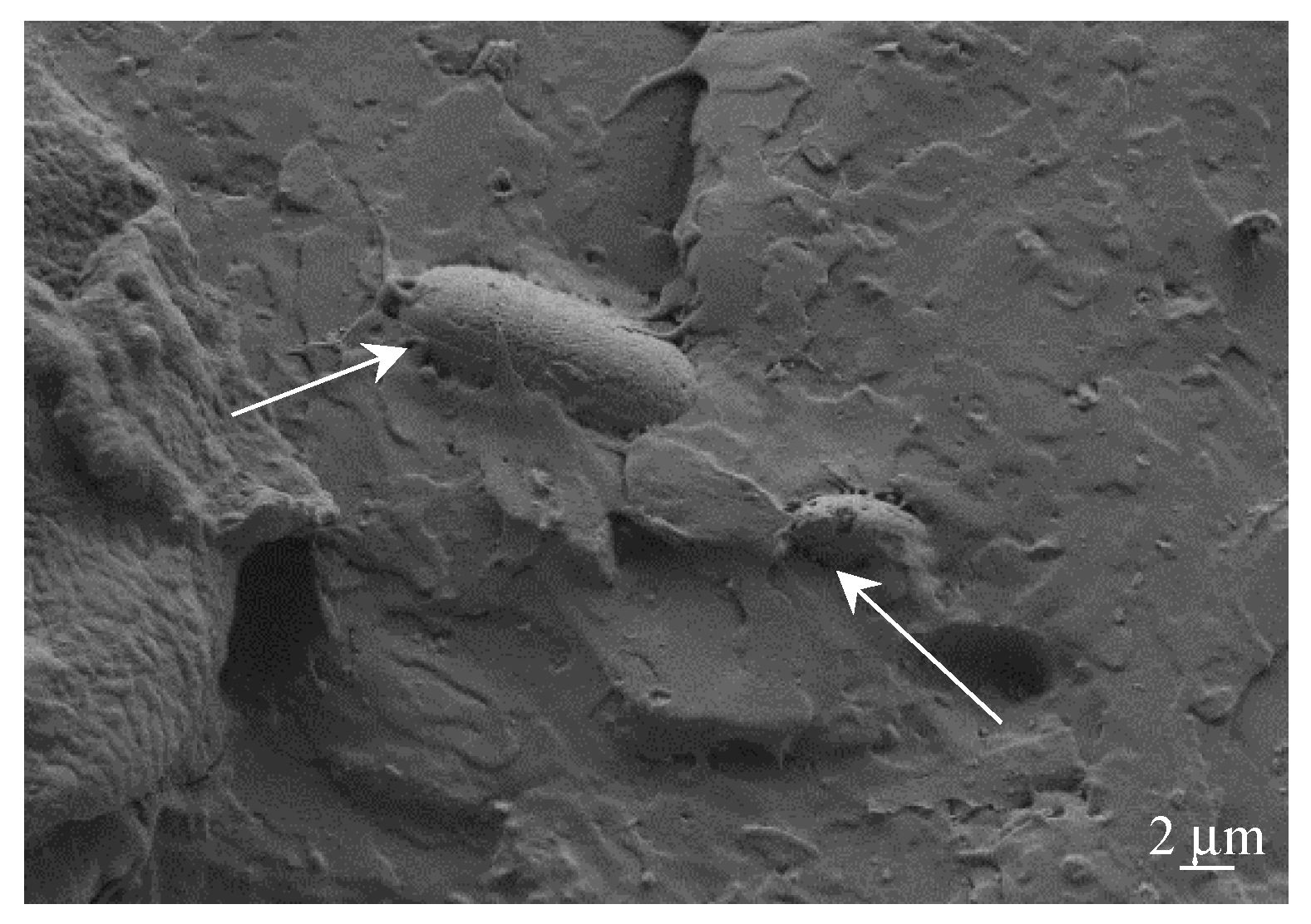
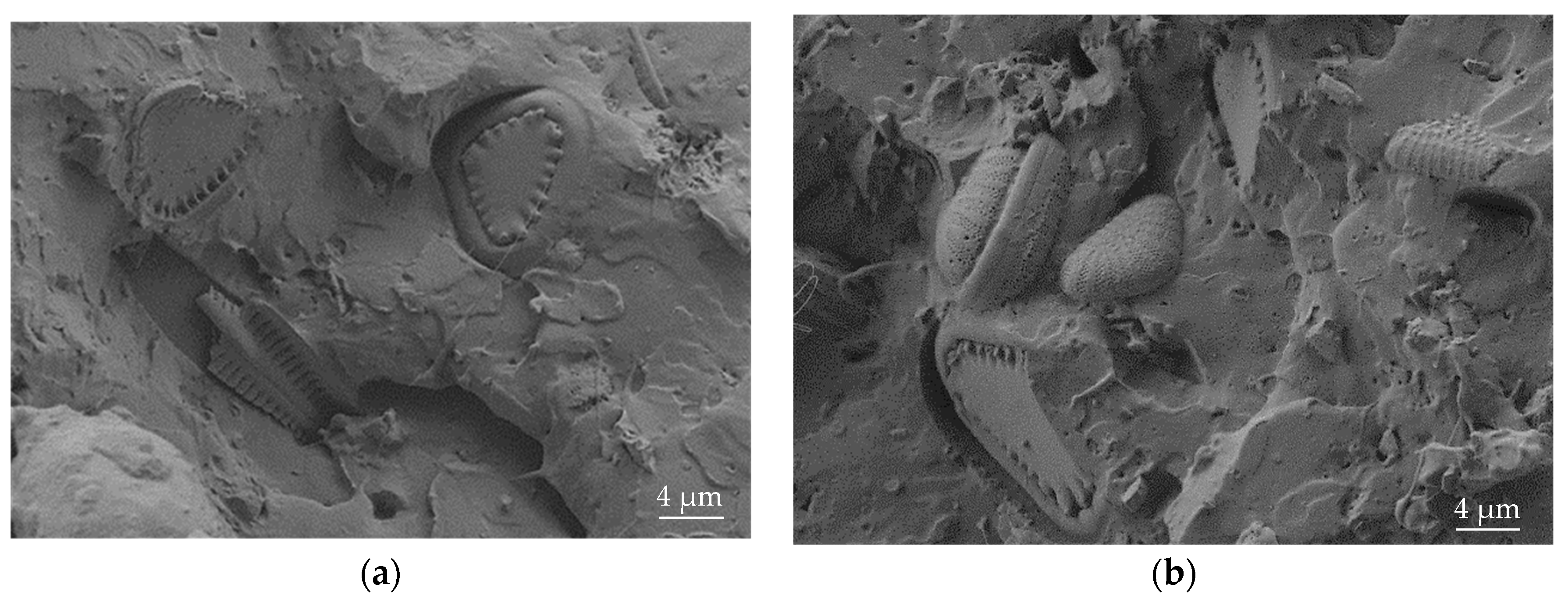
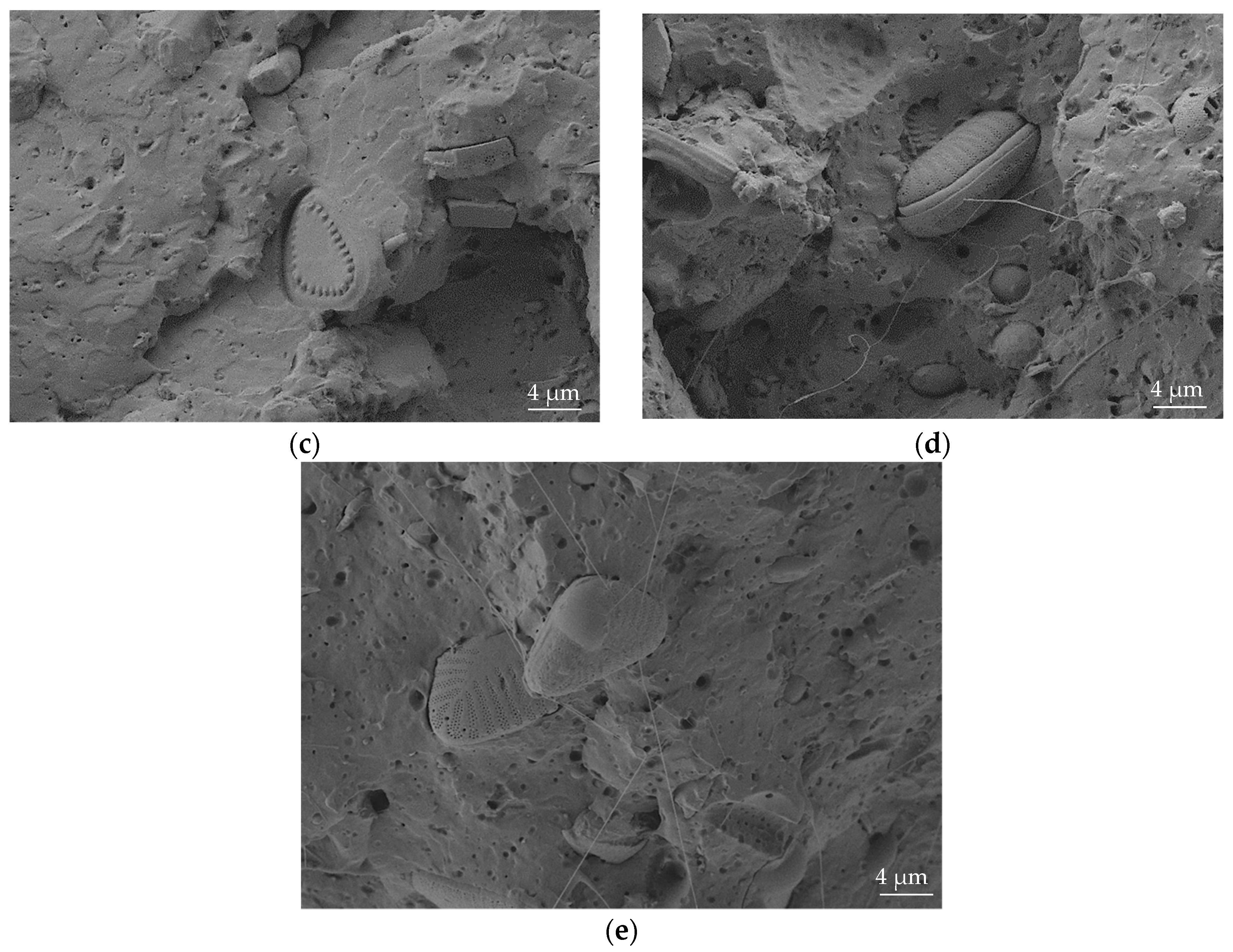
| Component | Weight Percentage (wt%) |
|---|---|
| SiO2 | 89.00 |
| Na2O + K2O | 1.88 |
| CaO | 6.73 |
| Al2O3 | 1.00 |
| Fe2O3 | 0.46 |
| Code | PLA (wt%) | DE (wt%) | MLO (phr) * |
|---|---|---|---|
| PLA | 100 | 0 | 0 |
| PLA+DE | 90 | 10 | 0 |
| PLA+DE+1MLO | 90 | 10 | 1 |
| PLA+DE+2.5MLO | 90 | 10 | 2.5 |
| PLA+DE+5MLO | 90 | 10 | 5 |
| PLA+DE+10MLO | 90 | 10 | 10 |
| PLA+DE+15MLO | 90 | 10 | 15 |
| Sample | Tg (°C) | Tcc (°C) | ΔHcc (J g−1) | Tm (°C) | ΔHm (J g−1) | χc (%) |
|---|---|---|---|---|---|---|
| PLA | 63.0 | 119.5 | 27.5 | 169.9 | 36.5 | 9.7 |
| PLA-DE | 63.8 | 111.8 | 19.5 | 171.3 | 32.7 | 15.7 |
| PLA-DE-1MLO | 61.8 | 105.7 | 21.6 | 169.7 | 33.85 | 14.7 |
| PLA-DE-2.5MLO | 61.3 | 105.2 | 21.5 | 170.0 | 33.6 | 15.0 |
| PLA-DE-5MLO | 60.2 | 105.5 | 21.2 | 169.5 | 31.2 | 12.5 |
| PLA-DE-10MLO | 62.1 | 105.5 | 16.9 | 172.0 | 26.9 | 13.0 |
| PLA-DE-15MLO | 61.5 | 105.6 | 18.7 | 172.4 | 28.1 | 13.0 |
| Sample | Tonset (°C) | Tmax (°C) | Residual Mass (wt. %) |
|---|---|---|---|
| PLA | 264.1 | 366.3 | 0.16 |
| PLA-DE | 294.3 | 364.3 | 11.6 |
| PLA-DE-1MLO | 316.7 | 369.6 | 11.5 |
| PLA-DE-2.5MLO | 316.2 | 367.4 | 13.8 |
| PLA-DE-5MLO | 315.6 | 367.3 | 10.0 |
| PLA-DE-10MLO | 302.0 | 364.6 | 10.3 |
| PLA-DE-15MLO | 309.3 | 361.6 | 10.2 |
| Sample | Tg (°C) * | Storage Modulus, G′ (MPa) at 40 °C |
|---|---|---|
| PLA | 68.1 | 564.9 |
| PLA-DE | 66.2 | 1095.5 |
| PLA-DE-1MLO | 65.9 | 831.9 |
| PLA-DE-2.5MLO | 65.8 | 624.3 |
| PLA-DE-5MLO | 64.5 | 588.8 |
| PLA-DE-10MLO | 64.2 | 518.4 |
| PLA-DE-15MLO | 63.2 | 545.9 |
| Sample | Tensile Modulus, Et (MPa) | Tensile Strength, σb (MPa) | Elongation at break, εb (%) | Impact Strength (kJ m−2) | Hardness Shore D |
|---|---|---|---|---|---|
| PLA | 900 ± 75 | 65 ± 0.5 | 6.3 ± 0.9 | 28 ± 3.4 | 80.5 ± 3.5 |
| PLA-DE | 1344 ± 54 | 53 ± 2.0 | 3.5 ± 0.3 | 12.4 ± 2.1 | 82.3 ± 2.2 |
| PLA-DE-1MLO | 1329 ± 70 | 50 ± 0.5 | 4.7 ± 0.2 | 13.4 ± 2.3 | 82.3 ± 2.1 |
| PLA-DE-2.5MLO | 1322 ± 20 | 46 ± 2.2 | 4.9 ± 0.3 | 14.6 ± 2.9 | 81.9 ± 1.6 |
| PLA-DE-5MLO | 1275 ± 48 | 40 ± 0.6 | 5.6 ± 0.4 | 15.6 ± 1.6 | 82.0 ± 2.2 |
| PLA-DE-10MLO | 1161 ± 117 | 33 ± 0.6 | 19.5 ± 2 | 18.4 ± 3.8 | 81.7 ± 1.6 |
| PLA-DE-15MLO | 1075 ± 166 | 33 ± 0.9 | 22.8 ± 1.9 | 21.7 ± 3.6 | 79.8 ± 2.9 |
© 2019 by the authors. Licensee MDPI, Basel, Switzerland. This article is an open access article distributed under the terms and conditions of the Creative Commons Attribution (CC BY) license (http://creativecommons.org/licenses/by/4.0/).
Share and Cite
Gonzalez, L.; Agüero, A.; Quiles-Carrillo, L.; Lascano, D.; Montanes, N. Optimization of the Loading of an Environmentally Friendly Compatibilizer Derived from Linseed Oil in Poly(Lactic Acid)/Diatomaceous Earth Composites. Materials 2019, 12, 1627. https://doi.org/10.3390/ma12101627
Gonzalez L, Agüero A, Quiles-Carrillo L, Lascano D, Montanes N. Optimization of the Loading of an Environmentally Friendly Compatibilizer Derived from Linseed Oil in Poly(Lactic Acid)/Diatomaceous Earth Composites. Materials. 2019; 12(10):1627. https://doi.org/10.3390/ma12101627
Chicago/Turabian StyleGonzalez, Lucia, Angel Agüero, Luis Quiles-Carrillo, Diego Lascano, and Nestor Montanes. 2019. "Optimization of the Loading of an Environmentally Friendly Compatibilizer Derived from Linseed Oil in Poly(Lactic Acid)/Diatomaceous Earth Composites" Materials 12, no. 10: 1627. https://doi.org/10.3390/ma12101627
APA StyleGonzalez, L., Agüero, A., Quiles-Carrillo, L., Lascano, D., & Montanes, N. (2019). Optimization of the Loading of an Environmentally Friendly Compatibilizer Derived from Linseed Oil in Poly(Lactic Acid)/Diatomaceous Earth Composites. Materials, 12(10), 1627. https://doi.org/10.3390/ma12101627







